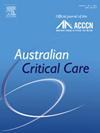不同漱口水对重症监护室患者呼吸机相关预后和死亡率的影响:网络荟萃分析
IF 2.6
3区 医学
Q2 CRITICAL CARE MEDICINE
引用次数: 0
摘要
背景:呼吸机相关肺炎是重症监护室 (ICU) 患者常见的并发症,可危及生命。保持口腔卫生对于降低呼吸机相关肺炎的发病率至关重要。在 ICU 环境中,有多种漱口水可用于口腔护理,但它们的比较效果仍不明确。本研究旨在系统评估和比较用于机械通气 ICU 患者口腔护理的常用漱口水的有效性和安全性:我们检索了 PubMed、Web of Science、Embase 和 Cochrane 图书馆中的随机对照试验 (RCT),比较了生理盐水、洗必泰、碳酸氢钠、氧化剂、草药提取物和聚维酮碘用于呼吸机通气 ICU 患者口腔护理的效果。研究结果包括呼吸机相关肺炎发病率、ICU死亡率、通气时间和大肠埃希氏菌固定值。通过网络荟萃分析(NMA)对直接和间接证据进行了综合分析。本研究已在国际注册系统综述和荟萃分析协议平台(International Platform of Registered Systematic Review and Meta-analysis Protocols, 2023120028)注册:结果:共纳入 14 项研究,1644 名参与者。与对照组相比,氧化剂有降低 VAP 发生率的趋势(风险比:0.24,95% 置信区间:0.05-1.10)。使用生理盐水与不使用漱口水相比,ICU 死亡率明显降低(风险比:0.18,95% 置信区间:0.04-0.88)。洗必泰、聚维酮碘和对照组的机械通气时间没有明显差异:结论:抗菌漱口水,尤其是洗必泰,对重症监护病房的患者有潜在风险;氧化溶液则相对安全。生理盐水是一种很有前途的替代品,可显著降低死亡率。然而,要证实这些发现并在 ICU 环境中建立循证口腔护理方案,仍然需要进行大规模、高质量的 RCT 研究:本研究已在国际注册系统综述和元分析协议平台(International Platform of Registered Systematic Review and Meta-analysis Protocols, 2023120028)注册。本文章由计算机程序翻译,如有差异,请以英文原文为准。
Effect of different mouthwashes on ventilator-related outcomes and mortality in intensive care unit patients: A network meta-analysis
Background
Ventilator-associated pneumonia is a common and life-threatening complication in intensive care unit (ICU) patients. Maintaining oral hygiene is crucial for reducing ventilator-associated pneumonia incidence. Various mouthwash solutions are used for oral care in ICU settings, but their comparative effectiveness remains unclear. This study aims to systematically evaluate and compare the efficacy and safety of commonly used mouthwashes for oral care in mechanically ventilated ICU patients.
Methods
We searched PubMed, Web of Science, Embase, and Cochrane Library for randomised controlled trials (RCTs) comparing saline, chlorhexidine, sodium bicarbonate, oxidising agents, herbal extracts, and povidone-iodine for oral care in ventilated ICU patients. Outcomes included ventilator-associated pneumonia incidence, ICU mortality, duration of ventilation, and Escherichia coli fixed value. A network meta-analysis (NMA) was conducted to synthesise direct and indirect evidence. This study is registered with the International Platform of Registered Systematic Review and Meta-analysis Protocols, 2023120028.
Results
FourteenRCTs with 1644 participants were included. Oxidising agents showed a trend towards reducing the incidence of VAP compared to the control group (risk ratio: 0.24, 95% confidence interval: 0.05–1.10). Administration of saline was associated with a notable reduction in ICU mortality (risk ratio: 0.18, 95% confidence interval: 0.04–0.88) versus no mouthwash. No significant differences were observed in the duration of mechanical ventilation between chlorhexidine, povidone-iodine, and the control group.
Conclusions
Antimicrobial mouthwashes, especially chlorhexidine, pose potential risks in ICU patients; oxidising solutions demonstrate relative safety. Saline solution emerges as a promising alternative, associated with a significant reduction in mortality rates. However, the need for large, high-quality RCTs remains paramount to substantiate these findings and establish evidence-based oral-care protocols in ICU settings.
Registration
This study is registered with the International Platform of Registered Systematic Review and Meta-analysis Protocols, 2023120028.
求助全文
通过发布文献求助,成功后即可免费获取论文全文。
去求助
来源期刊

Australian Critical Care
NURSING-NURSING
CiteScore
4.90
自引率
9.10%
发文量
148
审稿时长
>12 weeks
期刊介绍:
Australian Critical Care is the official journal of the Australian College of Critical Care Nurses (ACCCN). It is a bi-monthly peer-reviewed journal, providing clinically relevant research, reviews and articles of interest to the critical care community. Australian Critical Care publishes peer-reviewed scholarly papers that report research findings, research-based reviews, discussion papers and commentaries which are of interest to an international readership of critical care practitioners, educators, administrators and researchers. Interprofessional articles are welcomed.
 求助内容:
求助内容: 应助结果提醒方式:
应助结果提醒方式:


